Interview with Lidia Bastianich – Part 2 and a recipe for a Free-Form Peach Crostata

This article is a continuation from my interview with Lidia Bastianich at Felidia in New York City. You can read Part 1 here.
Part 2
“We need to go back to basics. Fifty percent or more of what we do to prepare food is about the product. The better the product, the less I have to do to it and the better the end result,” Lidia Bastianich told us. She is passionate about getting back to basics in both food and in life.
If you ever have the opportunity to visit Eataly (an Italian artisan food market in New York City co-owned by Lidia, Joe Bastianich, Mario Batali and Oscar Farinetti), you will find incredibly beautiful food: meats, fish, shellfish, breads, produce, and pastas. Fabulous basic ingredients. As you know if you cook at home, there is a huge difference in the outcome of a dish based on the quality of the ingredients that you use.
Lidia is also very concerned about many of the social issues surrounding food and the sustainability of our food production. “The world produces 120% of the food needed for human consumption and yet there is 30-40% hunger.” Waste and distribution challenges represent a big portion of the difference. Lidia went on to say, “We demand that perfectly marbled steak… the yield on that investment is not good. We need to modify, come closer to the earth. Eat simply. Eat straightforward. We can’t continue to push the edge. We need to eat the whole animal. Things are thrown out of balance and we are going backwards. You have to empower the people to make the right choices through education. Buy what is good for you.”
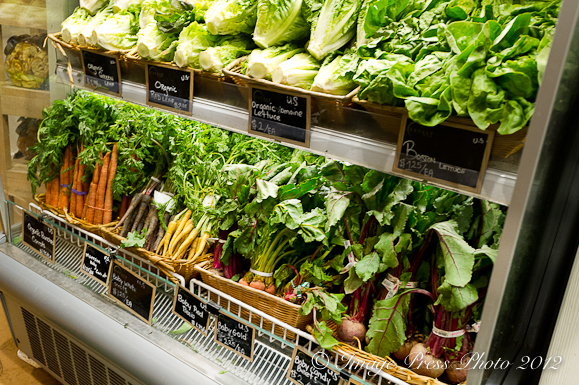
Beautiful produce at Eataly
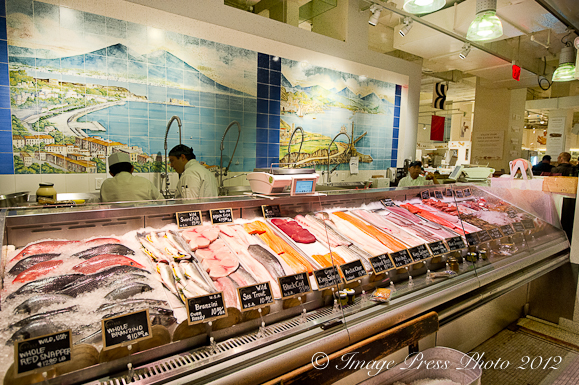
The seafood was impressive
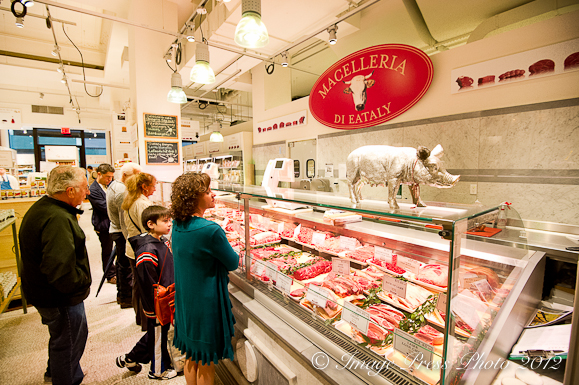
Meat counter at Eataly
In talking about simplifying life and going back to basics, Lidia wants people to really understand where our food comes from. “Many people are not comfortable buying and preparing food and they don’t know real food. They know boxes. They need to get back to the source. If they had a ripe red tomato, you don’t have to do much to it; a little olive oil and salt and pepper is all you need. Children think chickens come from a plastic wrapper. They don’t know.” I discussed this topic in my article, Honor the Animal. Lidia said, “When you take a cow to slaughter, that is the reality. If people get that connection, they will respect everything else more.”
She continued, “We take the wrong approach to food. Everything is negation. Don’t eat this, don’t eat that. It’s wrong. It causes problems. We need to talk about the positive. We need to eat the right things in the right seasons. Prepare great food simply and make it taste good.”
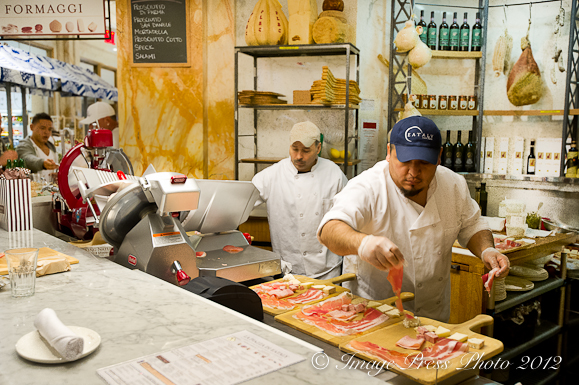
Charcuterie at La Piazza in Eataly
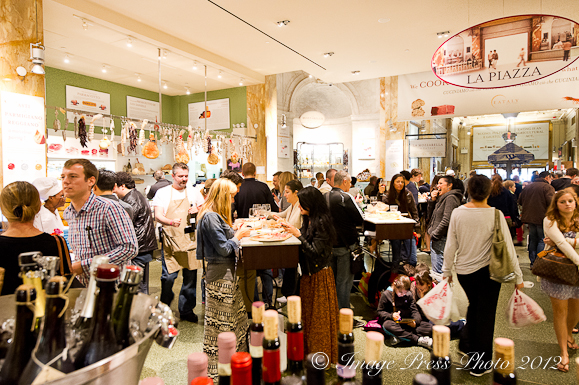
La Piazza
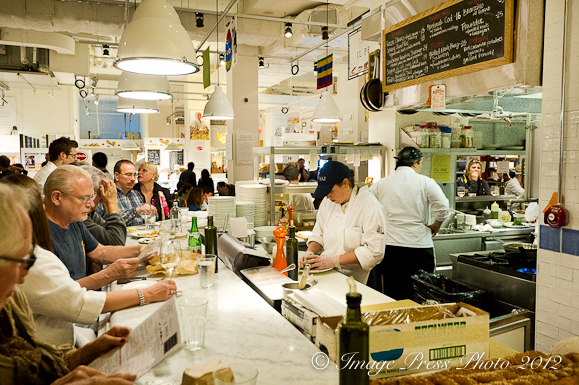
Il Pesce at Eataly
We have often written about the decline in the quality of our food that is available through most supermarkets. Food is now designed for transportation, cost, appearance, and shelf life with little or no concern about the taste, nutrition, and health benefits. Good quality food that is properly raised and harvested satisfies the mind and body. Food lacking in natural flavor, vitamins, and minerals does not. We often try to overcome the lack of natural flavor with seasonings and spice, but it cannot compensate for foods that are lacking in flavor to begin with.
Lidia talked about the same topic. “Most food doesn’t tell us anything. We eat a lot, but it is not satisfying. It is a problem. The Mediterranean diet is healthy. There is a lot of flavor and lots of color. Antipasto is intense in flavor. You have a few olives, meats, and cheeses and then maybe some pasta. Protein is only one third of what you eat. It satiates mentally. You need less and you are satisfied.” Lidia’s favorite pasta to cook at home is simply al dente pasta with olive oil, garlic, black pepper and Pecorino cheese.
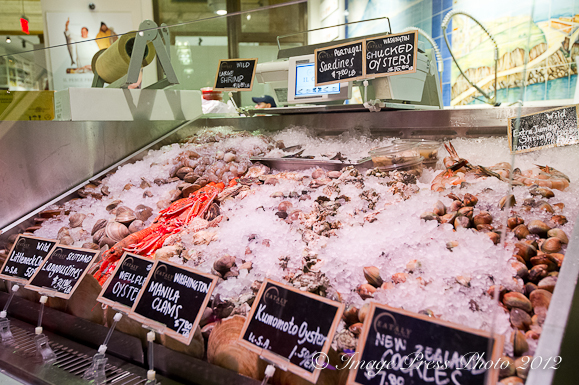
Fresh Langoustines, Clams, and Oysters
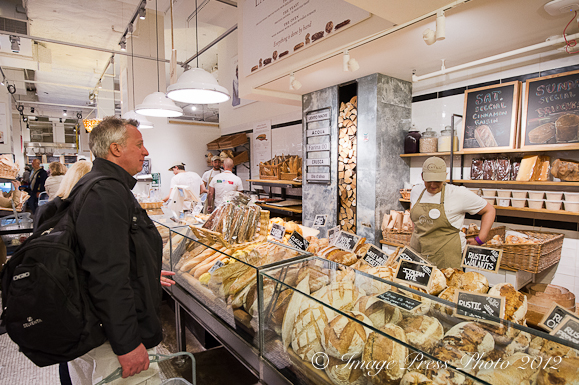
Artisan Breads
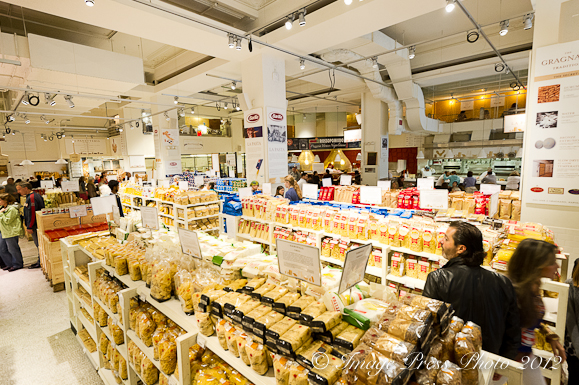
Imported Italian pasta in all shapes and sizes
What does Lidia enjoy doing when she is not working or spending time with family? “I love to travel. Food is part of travel. What is wonderful when you travel is you look at the topography and climate. You can almost predict the food and how they relate. I love that part. I love the social aspect of food and eating. I like going back to the earth and sitting on the floor, eating with your hands. It talks to me and tells me with the senses. Fingers tell you so much. It is all beautiful. I love to see food served without a knife and fork.”
Her heritage and travel to Italy are not the only source of Lidia’s inspiration. What other countries and their cuisine have influenced her cooking? “Asian food. I discovered it when I first came to the states. It is an old culture and as different as it is from Italian culture, there are some parallels. I have traveled to Vietnam, Japan, China and Thailand. I would still like to go to Korea. To know food from another place is to know more than a dish. I need time. I need to know what their spices are. I am not even close to knowing all of them in Asian food.”
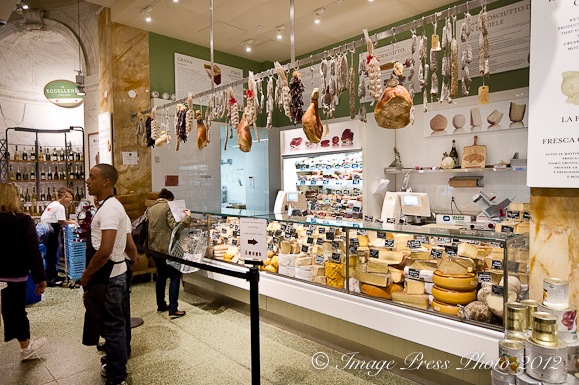
Imported cheeses and meats
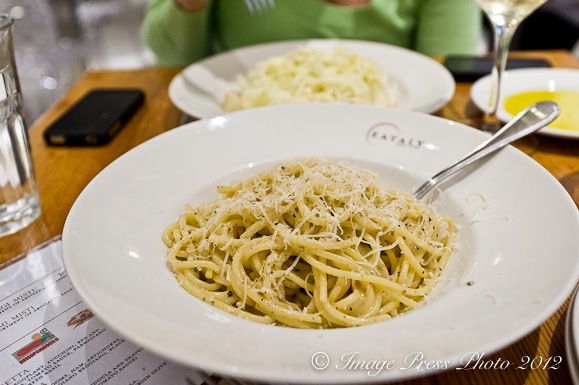
My favorite dish at Eataly was Spaghettone Cacio e Pepe
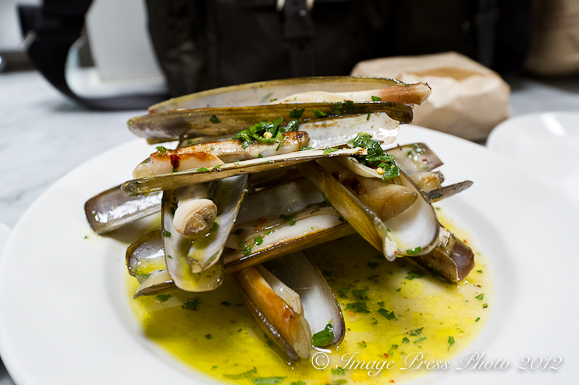
The razor clams were just like the ones we had in Barcelona
Lidia’s daughter Tanya and son Joe are a large part of her business empire. As she starts to think about the next chapter of her life, her family will continue to play an even more important role. “Retirement? I am thinking about it, ” Lidia told us. “I need a path, a precursor.” One thing has always led to another in her life. “It gives me great satisfaction to work with Tanya and Joe. Tanya can walk to my house and Joe lives 30 minutes away.” Tanya Bastinaich Manuali is a PhD, with degrees from Georgetown University and Syracuse University. She studied Italian Renaissance Art at Oxford University and has taught in Italy for both Boston University and Syracuse.
Her son, Joe Bastianich, left Wall Street to work with her on the restaurant expansions, Eataly, and the wineries based in Italy and is partner with Mario Batali in several restaurants, including Babbo. He is also involved in a number of other ventures.
Lidia’s mother, Erminia, age 93, who has made frequent appearances on Lidia’s shows and lives with Lidia, tends the garden at their home in New York City. Lidia’s five grandchildren are a big part of her life. Family is very important to her. Lidia shared, “Things move so fast in today’s world. It is unstable and we need stability. The whole world is pushing our kids ahead and forgetting about the back generations and the grandmas.”
“I wrote a children’s story for Christmas (Nonna Tell Me a Story: Lidia’s Christmas Kitchen). It is not just about Nonna (the Italian word for Grandmother) telling a story. There is a recipe. We finish the story and then do the recipe. I don’t just tell, we do,” Lidia told us. I remember spending a great deal of time with my grandmother when I was a young girl and it made a difference in my life. I do think we have lost that connection.
“We forget about the unconditional love, wisdom, richness and stability of our grandparents. I grew up with this and I know. I need to talk about this,” Lidia was passionate. “It’s a social plus for the kids. My young ones are growing. Where do they want to go? How can I help them get there? Grandmothers can be the inspiration for this.”
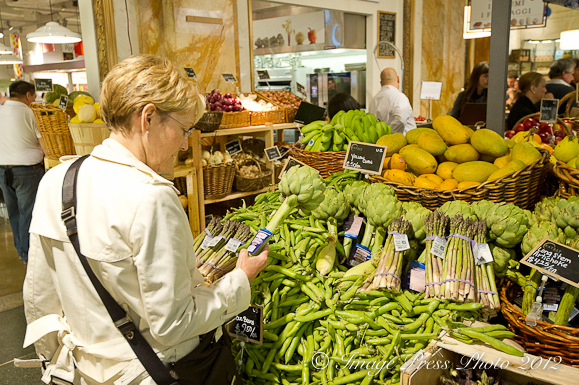
These were incredibly beautiful and fresh ingredients
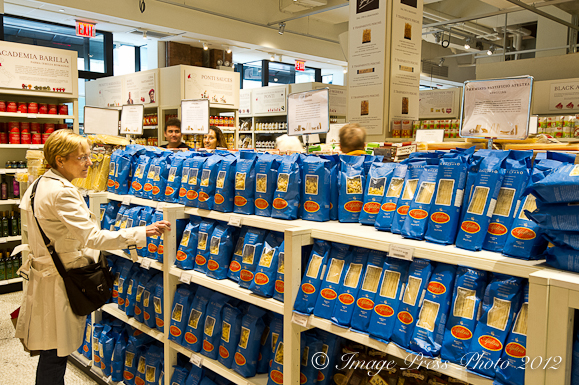
We brought home a supply of imported pasta
A final thought from Lidia on food and our lifestyle choices, “Life should be about passion. Not so programmed. Big companies say they are making our lives easier, but it’s more complicated. We need to return to basics.”
We want to thank Lidia for the time she spent with us and the passion that she brings to everything she does. Our conversation was like chatting with a close friend that shares the same values and feelings. I hope that we can bring more of that sentiment and knowledge to our readers.
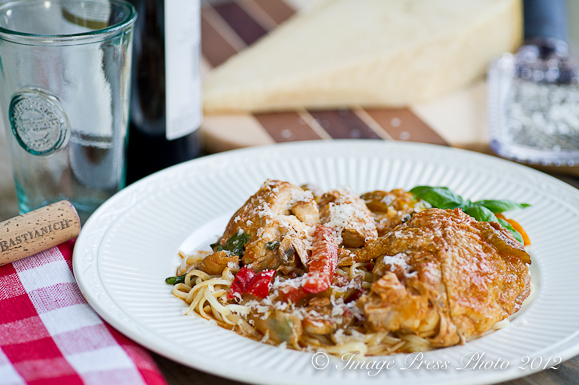
Chicken Cacciatore from Lidia’s Italy in America
I have made several of Lidia’s recipes in the past few weeks. One was for Rice and Zucchini Crostata (Torta di Riso e Zucchine) from Part 1 of my interview with Lidia. I also prepared a wonderful recipe for Chicken Cacciatore from Lidia’s Italy in America. The flavors in both dishes were excellent.
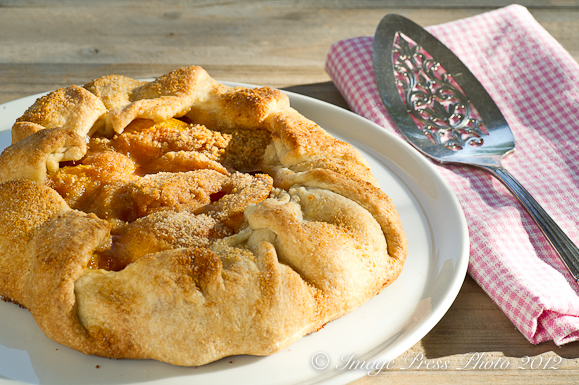
The natural sweetness of the ripe South Carolina peaches are featured in this dessert
For this article, I chose to make a Free-Form Peach Crostata since South Carolina peaches are at their peak with wonderful, juicy and sweet cling-free peaches available at almost every farmstand and Farmers’ Market in North Carolina, South Carolina, and Georgia. I used Lidia’s recipe for a crostata with Italian prune plums and substituted fresh peaches, as she suggests substituting any other ripe fruit.
I love the simplicity of this rustic tart. It is perfect for entertaining in the summer, especially when topped with a scoop of homemade vanilla ice cream. The crust was perfect and flaky and really highlights the flavor of the peaches. We enjoy tasting the natural sweetness of the fruit. If you want a sweeter crostata, you might add a little more sugar.
Bunkycooks will have more articles on Lidia’s Italy in the near future. In the meantime, Ciao!
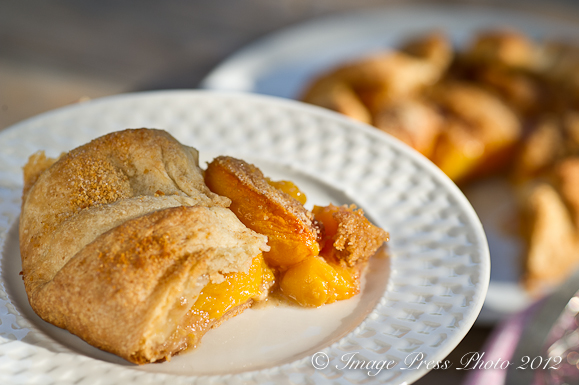
The crust is light and flaky and perfect with the peaches
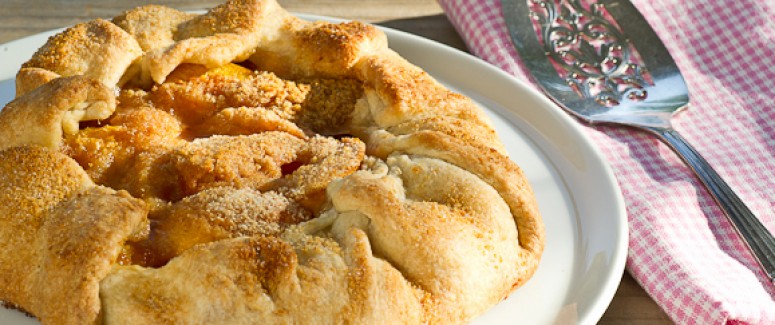
Free-Form Peach Crostata
Ingredients:
For Crostata Dough
1 cup all-purpose flour
2 tablespoons sugar
1/8 teaspoon salt
5 tablespoons butter, very cold
4 tablespoons water, very cold
For the Fruit Filling
1 1/2 pounds prune plums, or other ripe fruit
(I used South Carolina peaches)
Zest of 1 lemon, finely grated
2 tablespoons apricot jam
2 tablespoons butter, cut in pieces
For the Sweetened Bread Crumbs
1/2 cup fine dry bread crumbs
2 tablespoons zucchero di canna, or white sugar
1/4 teaspoon powdered cinnamon
For Serving (Optional)
Whipped cream or
vanilla ice cream
Directions:
For the Dough
1. Put the flour, sugar and salt in the bowl of a food processor fitted with the metal blade and process for a few seconds to mix the dry ingredients.
2. Cut the butter into 1/2-inch pieces, drop them onto the flour, and pulse the machine 10 or 12 times, in short bursts, 20 seconds in all. The mixture should be crumbly with only a few larger bits of butter visible.
3. Sprinkle 3 tablespoons of water on top of the dough-immediately pulse about 6 times, only a second or two each time. You want the crumbs to gather together in wet clusters, a bit like cottage cheese curds-don’t expect a mass of dough to form. If they haven’t gathered, sprinkle on more water, a teaspoon at a time, and pulse 2 or 3 times after each.
4. When the clusters form, scrape them all out of the bowl, press them together and knead just for a few seconds to form smooth, tight dough. Flatten it into a disk, wrap well in plastic wrap and refrigerate for 3 hours or up to a day before using. Freeze the dough for longer keeping.
(If the crumbs haven’t clustered after you’ve added 4 tablespoons of water, open the top and press them with your fingers-if they’re wet and stick together, just empty the bowl and press them into a disk of dough.)
Making the Filling and Rolling the Dough
1. Arrange a rack in the middle of the oven with a baking stone on it, if you have one. Preheat the oven to 375 degrees. If the crostata dough is very cold, let it soften at room temperature for a few minutes while you make the filling.
2. Rinse the plums and pat dry. Cut them in flat halves, following the natural line around the fruit through the stem end, and remove the pits. Toss the halves with the lemon zest, apricot jam and butter bits in a mixing bowl. (If you’re making the crostata with large plums or fruits like peaches or nectarines, cut them in quarters or wedges. *I peeled my peaches before slicing them.)
3. Toss the bread crumbs, sugar and cinnamon together.
4. On a lightly floured board, start stretching the dough into a circle, rolling from the center in all directions. Turn the dough over as it stretches and flour the work surface as needed. Cut a piece of parchment that will cover your baking sheet. Roll the circle of dough to a diameter of 15-inches and lay it, centered, on the parchment. Now trim the outside edges of the dough, with a sharp knife or scissors, cutting away ragged or thin spots and making as perfect a round as you can, since this edge will be visible on the top of your crostata. Keep the circle at least 13-inches diameter. Lift the parchment with the dough on it to the baking sheet.
Filling and Baking the Crostata
1. Sprinkle about 1/3 cup of the bread crumb mix in a 7 to 9-inch diameter circle in the center of the dough, as a base for the fruit. The bread crumbs will soak up the juices, so if you have very ripe and juicy fruit (like peaches), use more crumbs to form a thicker layer; if using a drier fruit, like apricots, use less crumbs.
Arrange the coated plum halves, cut side up, on top of the crumb base. I place them in concentric rings, starting from the outside, and lean each inner ring on the plums just outside. In this manner, with a larger 8 or 9-inch base of crumbs, you should be able to fit all the plums in one layer, for a crostata with an even height. If the crumb base is smaller, you’ll need to pile up the fruit. This will give the crostata more of a dome shape.
2. When you’ve assembled your fruit in the middle of the dough, you’ll fold the uncovered band of pastry on top of the fruit. The width of the band will vary with your arrangement of the plums, but you should have at least 2-1/2 inches of dough to form the pleated top crust. Finally, sprinkle 1 or more tablespoons of sugared bread crumbs over the visible fruit in the center. As before, use more crumbs on juicy fruit. If you have any left over, sprinkle them over the pleated dough.
3. Put the baking sheet with the crostata into the oven, on the stone if using one, and bake for 25 minutes; rotate the pan back to front for even cooking. Continue baking and check the browning of the crust after 40 minutes: it should be light gold. If it is getting quite dark, you may need to lay a piece of foil on top. Bake for another 15 minutes or more until the fruit is bubbling and has caramelized on the edges. If you’ve filled the crostata with a mound of fruit, you’ll probably want to bake it more than an hour-and cover the top-to make sure all the fruit is cooked.
4. Let the crostata cool on the baking sheet for about 15 minutes or more before lifting it, with the parchment, to a wire rack to continue cooling. When it has set, slide it off the parchment, supported by long spatulas, onto a platter. Serve warm or at room temperature, cut in wedges, with whip cream or vanilla if you wish.
Lidia Bastianich
Recipe courtesy of LidiasItaly.com